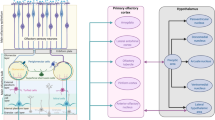Abstract
New insights into the mechanism of hunger and satiety provide a new approach to an old problem of weight regulation. It is known that the sense of olfaction via this olfactory-satiety feedback loop has a powerful and immediate effect on appetite regulation. The goals of this present study were to test the association of the inhalation of the specially formulated hedonic scents and weight reduction in a double blind, randomized, controlled study. This study tests the hypothesis that inhalation of specially formulated, positive-hedonic scents can function in the acute regulation of appetite and contribute to satiety. We also test the hypothesis that the inhalation of positive hedonic scents can lead to sustained weight loss. Our study conclusively proves in a randomized, controlled, double-blind fashion that the inhalation of specially formulated scents are effective in appetite reduction, squelching food cravings and weight loss without any conscious dieting or exercising.
Similar content being viewed by others
References
Kuczmarski RJ, Flegal KM, Campbell SM, et al: Increasing prevalence of overweight among US adults: The National Health and Nutrition Examination Surveys, 1960 to 1991. JAMA 1994; 272: 205–211.
Kurscheid T, Lauterbach K. The cost implications of obesity for health care and society. Int J Obes Relat Metab Disord 1998 Aug; 22 Suppl 1:S3–5; discussion S6.
McGinnis JM, Foege WH. Actual causes of death in the US. JAMA 1993, 270: 2207–2212.
Colditz GA. Economic costs of obesity. Am J Clin Nutr 1992 55 (2 Suppl):503S–507S.
Pi-Sunyer Fx. Medical Hazards of Obesity. Ann Intern Med 1993; 119: 655–660.
Martin LF, Hunter SM, Lauve RM, et al. Severe obesity: expensive to society, frustrating to treat, but important to confront. South Med J 1995; 88: 895–902.
Goldstein DJ. Beneficial health effects of modest weight loss. Int J Obes Relat Metab Disord. 1992; 16: 397–414.
Methods of Voluntary weight loss and Control. National Institutes of Health Technology Assessment Conference Statement, March 30–April 1 1992.
Hirsch AR, Dougherty DD. Inhalation of 2-acetylpyridine for weight reduction. Chem Senses 1993; 18: 570–572.
Hirsch AR, Gomez R. Weight reduction through inhalation of odorants. J Neurol Orthoped Med Surg 1995; 16: 26–31
Warwick ZS, Hall WF, Pappas TN, et al. Taste and smell sensations enhance the satiating effect of both a high-carbohydrate and high-fat meal in humans. Physiol Behavior 1993; 53: 553–563.
Martin, GN. Olfactory influences on the human EEG. J Psychophysiol 1996; 995: 183.
Martin, GN. Ofactory influences on the human neocortical EEG response to food odour. Chemical Senses 1992; 17: 862.
Martin, GN. Brain electrical activity mapping and the human sense of smell. J. Psychophysiol 1993; 7: 265.
Plata-Salaman CR. Regulation of hunger and satiety in man. Dig Dis 1991; 9:253–268.
Breer H. Odor recognition and second messenger signaling in olfactory receptor neurons. Semin Cell Biol. 1994; 5: 25–32.
Brodal A. Neurological anatomy in relation to clinical medicine. 3rd ed. New York: Oxford University Press, 1981; 653, 751.
Sullivan SL, Ressler KJ, Buck LB. Odorant receptor diversity and patterned gene expression in the mammalian olfactory epithelium. Prog Clin Biol Res. 1994; 39: 75–84.
Greer CA. Structural organization of the olfactory system. In: Getchell TV, Doty TL, Bartoshuk LM, Snow JB, eds. Smell and taste in health and disease. New York: Raven Press, 1991; 78.
Rousseaux M, Muller P, Gahide I, et al. Disorders of smell, taste, and food intake in a patient with a dorsomedial thalamic infarct. Stroke 1996; 27: 2328–2330.
Critchley HD, Rolls ET. Hunger and satiety modify the responses of olfactory and visual neurons in the primate orbitofrontal cortex. J Neurophysiol 1996; 75: 1673–1686.
Author information
Authors and Affiliations
Rights and permissions
About this article
Cite this article
Mayer, S.N., Davidson, R.S. & Hensley, C.B. The Role of Specific Olfactory Stimulation in Appetite Suppression and Weight Loss . Journal of Advancement in Medicine 12, 13–21 (1999). https://doi.org/10.1023/B:JAME.0000008711.62500.df
Issue Date:
DOI: https://doi.org/10.1023/B:JAME.0000008711.62500.df




